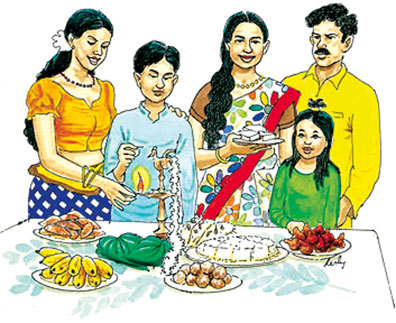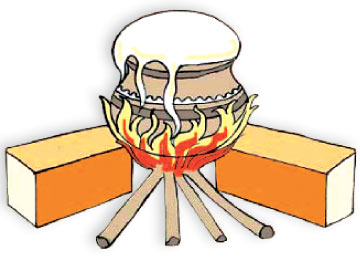Dawn of the Sinhala and Hindu New Year
In Sinhala households
Household preparations are done in advance prior to the festival;
homes are re-painted, floors are polished and kitchens are cleaned,
making it clean and tidy to mark a new beginning. Sweetmeats are
prepaired and new clothes are purchased.
 As
the sun exits Meena, people take the final bath of the old year. As the
punya kalaya or nonagathaya (inauspicious time) begins all business and
work related activities come to a halt. Everyone engages in spiritual
activities by visiting temples. As
the sun exits Meena, people take the final bath of the old year. As the
punya kalaya or nonagathaya (inauspicious time) begins all business and
work related activities come to a halt. Everyone engages in spiritual
activities by visiting temples.
Dawn of the New Year - Aluth Avurudu Udawa
The sound of firecrackers and the rhythm of the rabana (a one-sided
traditional drum) signal that it’s the dawn of a new beginning – Aluth
Avurudda. As the New Year begins, families get ready for the rituals.
After the rituals various games and many other fun-filled activities
begin.
The traditional pooja
The new year pooja is a conducted to thank the gods for the previous
year and to seek their blessings for the forthcoming year. The housewife
sets up the Kumbam - a silver pot with coconut on top adorned with mango
leaves on the sides, along with fruits such as mangoes, jak, and a comb
of bananas and sweets are laid in front of the gods as an offering. When
the ceremonies are over at home, the families visit temples during the
Punya Kaalam and take part in spiritual activities.
 Kai
visesham Kai
visesham
The Kai Visesham is a ceremony during where the elders offer money to
the young as the first financial transaction of the year which brings
good luck.
In the evening various games such as Porthenkai (a game played with
coconuts), uriyadi (pot-breaking), pole climbing and tug-o-war are
conducted with the neighbours.
In Hindu households Morning of the New Year
At the dawn of the New Year, families rise early and collect Maruthu
neer, a special water that contains a mix of herbal leaves and flowers
such as lotus, pomegranate and a few others. This ritual is considered
an act of purification and generally Maruthu neer is anointed at an
auspicious time.
The spirit of New Year sets in when everyone in new clothes wish
family and friends Puthandu Valthukkal (Happy New Year).
Later, families gather at the entrance to the house where a potful of
milk is boiled. As the first rays of the new year fall, watching the
milk overflow brings boundless joy into ones life. The milk is used to
make pongal rice - a type of sweetened rice made in Hindu homes during
festivals. The Pongal rice is made at a specific time when the sun moves
from the Meena Rasi ( Pisces) to Mesha rasi (Aries).
Internet
 [Auspicious
times for the New Year] [Auspicious
times for the New Year]
* Dawn of the New Year - Avurudu Udawa - April
13 at 7.48 p.m.
* Religious Activity - Punya Kalaya - April 13
at 1.24 p.m. till April 14, 2.12 a.m.
* Preparing meals - Ahara Piseema - April 13 at
8.06 p.m. wearing green colour clothes and facing South.
* Taking meals - Ahara Anubavaya, Starting work
- Weda Alleema and transactions- Ganu denu - April 13, 8.54 p.m. wearing
green colour and facing South.
* Anointing oil - Hisa Thel Gaama - April 16,
10.41 a.m. wearing blue and facing West.
* Going to work - Rakee Raksha - April 18, 6.27
a.m. wearing white and facing East. |

